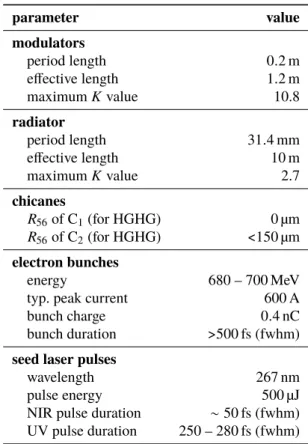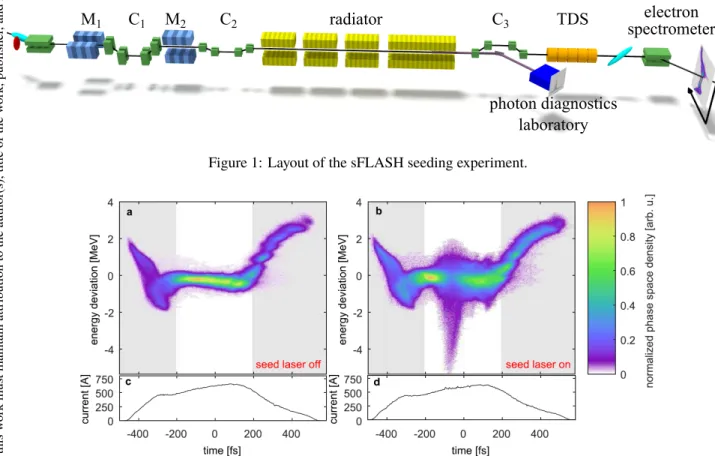STATUS OF THE sFLASH EXPERIMENT
∗C. Lechner
†, R. W. Assmann, J. Bödewadt, V. Grattoni, I. Hartl,
M. M. Kazemi, T. Laarmann, A. Przystawik, DESY, 22607 Hamburg, Germany S. Khan, T. Plath, DELTA, TU Dortmund University, 44227 Dortmund, Germany
A. Azima, H. Biss, M. Drescher, W. Hillert, L. L. Lazzarino, V. Miltchev, J. Rossbach, University of Hamburg, 22761 Hamburg, Germany
Abstract
The sFLASH experiment at the free-electron laser (FEL) FLASH1 is a setup for the investigation of external FEL seeding. Since 2015, the seeding scheme high-gain har- monic generation (HGHG) is being studied. At the end of the seeded FEL, an RF deflector enables time-resolved anal- ysis of the seeded electron bunches while the photon pulses can be characterized using the technique of THz streaking.
In this contribution, we present the current configuration of the experiment and give an overview of recent experimental results.
INTRODUCTION
Free-electron lasers (FELs) deliver photon pulses of un- paralleled brilliance. In the soft and hard x-ray wavelength ranges, the exponential amplification process in these de- vices is typically initiated by spontaneous undulator radi- ation emitted as the high-brightness electron bunch enters the undulator. This stochastic start-up in the so-called self- amplified spontaneous emission (SASE) mode of operation entails poor longitudinal coherence of the generated photon pulses.
To initiate the FEL process in a well-controlled way, so- called seeding techniques were conceived. Here, the FEL amplification process is initiated and controlled by coher- ent light pulses from an external source. At sFLASH, we currently study the high-gain harmonic generation (HGHG) seeding scheme [1].
The seeding experiment sFLASH is installed at the FLASH1 beamline of the FEL user facility FLASH [2], which has been in operation since 2005, delivering high- brilliance SASE FEL radiation down to 4.2 nm. The su- perconducting linear accelerator generates high-brightness electron bunches with energies up to 1.25 GeV in bursts of up to 800 electron bunches (at a 1-MHz repetition rate) with 10 bursts per second. The electron bunches are distributed over the undulator beamlines FLASH1 and FLASH2 using a flat-top kicker and a Lambertson DC septum [2]. This enables FEL operation in both undulator beamlines at the full 10-Hz repetition rate of the linear accelerator [3–5].
EXPERIMENTAL SETUP
Figure 1 shows the essential components of sFLASH, their parameters are compiled in Table 1. The electron bunches
∗Work supported by Federal Ministry of Education and Research of Ger- many under contract No. 05K13GU4, 05K13PE3, and 05K16PEA.
†christoph.lechner@desy.de
Table 1: Experimental Parameters
parameter value
modulators
period length 0.2 m
effective length 1.2 m
maximumKvalue 10.8
radiator
period length 31.4 mm
effective length 10 m
maximumKvalue 2.7
chicanes
R56of C1(for HGHG) 0 µm
R56of C2(for HGHG) <150 µm electron bunches
energy 680 – 700 MeV
typ. peak current 600 A
bunch charge 0.4 nC
bunch duration >500 fs (fwhm) seed laser pulses
wavelength 267 nm
pulse energy 500 µJ
NIR pulse duration ∼50 fs (fwhm) UV pulse duration 250 – 280 fs (fwhm)
arriving from the linear accelerator and the seed laser pulses interact in two electromagnetic wigglers with 5 full peri- ods [6, 7] (M1 and M2 in Fig. 1) of orthogonal polariza- tion. After each wiggler, a 4-dipole chicane is installed (C1
and C2in Fig. 1). In the subsequent, 10-m-long variable- gap radiator, FEL emission takes place. The resulting light pulses are extracted from the electron beamline and can be transported either to in-tunnel photon diagnostics (en- ergy detector, fluorescence screens, and a spectrometer with λ/∆λ≈500) or to a photon diagnostics laboratory outside of the accelerator tunnel. The longitudinal phase space of the electron bunches can be diagnosed with the combination of a transverse-deflecting structure (TDS) and an energy spectrometer.
Seed Laser System
For seeding experiments, a dedicated near-infrared (NIR) Ti:sapphire laser system is available. The 267-nm ultra- violet (UV) seed laser pulses are generated by third- harmonic generation (THG) from the 800-nm laser pulses.
9th International Particle Accelerator Conference IPAC2018, Vancouver, BC, Canada JACoW Publishing
ISBN:978-3-95450-184-7 doi:10.18429/JACoW-IPAC2018-TUPMF085
02 Photon Sources and Electron Accelerators A06 Free Electron Lasers
TUPMF085 1471
ContentfromthisworkmaybeusedunderthetermsoftheCCBY3.0licence(©2018).Anydistributionofthisworkmustmaintainattributiontotheauthor(s),titleofthework,publisher,andDOI.
Figure 1: Layout of the sFLASH seeding experiment.
Figure 2: Longitudinal phase-space distributions of electron bunches measured with the transverse-deflecting structure installed downstream of the sFLASH radiator. The reference bunches(a)were acquired with seed laser off. With seed laser on, the signature of the FEL lasing (here at the 7th harmonic) is clearly visible in the longitudinal phase-space distribution (b). Reprinted from [9] under the Creative Commons Attribution 4.0 International License [10].
At the entrance to the in-vacuum transport to the modulator, the maximum UV pulse energy is 500 µJ. The longitudi- nal position of the beam waists in the electron beamline is controlled by UV telescopes and the waist position and size are diagnosed by means of Ce:YAG fluorescence screens installed around M2.
TIME-RESOLVED CHARACTERIZATION OF SEEDED FEL PULSES
With sFLASH in HGHG-seeded operation (using modu- lator M2and chicane C2), we implemented two methods to diagnose the longitudinal photon pulse profile: TDS-based analysis of the seeded electron bunches leaving the radiator and THz streaking of the photon pulses.
Analysis of the Seeded Electron Bunches
The exponential FEL amplification process alters the lon- gitudinal phase-space distribution of the electron bunch.
Comparing longitudinal phase-space distributions acquired with and without FEL lasing enables to extract the longitudi- nal power profile of the photon pulse on a single-shot basis.
This was first demonstrated at the SASE FEL LCLS [8]. At sFLASH, this technique was applied for the first time at a seeded FEL [9]. Without a seed laser pulse, the 10-m-long radiator operates as SASE FEL, extracting only a negligible
amount of energy from the bunches (Fig. 2(a)). In Fig. 2(b), the signature of FEL lasing selectively initiated by the seed laser pulse is clearly visible. This energy drop of the elec- trons reveals the power profile of the FEL pulse. Scanning the seed over the bunch enables local sampling of the lasing performance within the electron bunch [9].
THz Streaking of Photon Pulses
The seeded FEL pulses can also be studied using THz streaking, a photon-based analysis technique (see for in- stance [11]). In the setup realized in the photon diagnostics laboratory [12], the seeded FEL pulse is overlapped in a gas target with a THz pulse produced from a fraction of the NIR pulses driving the UV seed source. This translates the longi- tudinal information of the photon pulse into a photoelectron spectrum that is acquired with a time-of-flight spectrometer.
Comparison of the two Techniques
Using these techniques, seeded FEL pulses at the 8th har- monic (wavelength 33.4 nm) were analyzed [12]. With the TDS-based analysis of the electron bunch, a pulse duration of(57±14)fs was found while with THz streaking we deter- mined the pulse duration to be(54±7.5)fs. Moreover, THz streaking provides access to the optical phase of the seeded
9th International Particle Accelerator Conference IPAC2018, Vancouver, BC, Canada JACoW Publishing
ISBN:978-3-95450-184-7 doi:10.18429/JACoW-IPAC2018-TUPMF085
TUPMF085 1472
ContentfromthisworkmaybeusedunderthetermsoftheCCBY3.0licence(©2018).Anydistributionofthisworkmustmaintainattributiontotheauthor(s),titleofthework,publisher,andDOI.
02 Photon Sources and Electron Accelerators A06 Free Electron Lasers
FEL pulses and the average chirp of the seeded FEL pulses was found to be(−1940±800)THz/ps [12].
Towards Tailored Seeded FEL Pulses
In a simulation study carried out using the FEL code Gen- esis [13], the impact of additional group-delay dispersion (GDD) acting on the seed laser pulses on the properties of the HGHG-seeded photon pulses was studied [14].
SUMMARY AND OUTLOOK
At the seeding experiment sFLASH, two analysis meth- ods revealing longitudinal properties of the generated light pulses were applied to an HGHG-seeded FEL operating at 33.4 nm. The results obtained from a TDS-based analysis of the electron bunches leaving the undulator and using THz streaking of the photon pulses were found to be in good agreement. The analyzed seeded photon pulses exhibit an average chirp of(−1940±800)THz/ps.
The already existing hardware offers numerous research opportunities: Seeded electron bunches can be transported from the sFLASH section to the entrance of the FLASH1 main undulator. This would enable seeded operation of the fixed-gap FLASH1 main undulator [15]. Moreover, first stud- ies of the advanced seeding scheme echo-enabled harmonic generation (EEHG) [16] are under preparation. Currently, the relatively low longitudinal dispersion R56 of the first chicane (C1) is limiting the accessible parameter space [17].
To lift these restrictions, an upgrade of this chicane aiming atR56≈4 mm at 700 MeV is being engineered.
ACKNOWLEDGEMENTS
Without the help from many groups at DESY, the prepa- ration and commissioning of all components of the seeding experiment would not have been conceivable. Their support is gratefully acknowledged.
REFERENCES
[1] L.H. Yu, “Generation of intense uv radiation by subharmoni- cally seeded single-pass free-electron lasers”,Phys. Rev. A, vol. 44, p. 5178, 1991.
[2] M. Vogtet al., “Status of the Superconducting Soft X-Ray Free-Electron Laser FLASH at DESY”, presented at the 9th Int. Particle Accelerator Conf. (IPAC’18), Vancouver, BC, Canada, Apr. 2018, paper TUPMF090, this conference.
[3] B. Faatzet al., “Simultaneous operation of two soft x-ray free-electron lasers driven by one linear accelerator”,New J.
Physics, vol. 18, p. 062002, 2016.
[4] J. Rönsch-Schulenburget al., “Experience with Multi-Beam and Multi-Beamline FEL-Operation”, inProc. 8th Int. Par- ticle Accelerator Conf. (IPAC’17), Copenhagen, Denmark, May 2017, pp. 2621–2624.
[5] T. Plathet al., “Free-electron laser multiplex driven by a su- perconducting linear accelerator”,J. Synchrotron Radiation, vol. 23, p. 1070, 2016.
[6] G. Angelovaet al., “Installation of the Optical Replica Syn- thesizer in FLASH”, inProc. 27th Int. Free-Electron Laser Conf. (FEL’07), Novosibirsk, Russia, 2007, pp. 438–440.
[7] J. Bödewadtet al., “Experience in Operating sFLASH With High-Gain Harmonic Generation", inProc. 8th Int. Parti- cle Accelerator Conf. (IPAC’17), Copenhagen, Denmark, May2017, pp. ,2596–2599.
[8] C. Behrenset al., “Few-femtosecond time-resolved measure- ments of X-ray free-electron lasers’,Nat Commun.vol. 5, p.
4762, 2014.
[9] T. Plathet al., “Mapping few-femtosecond slices of ultra- relativistic electron bunches’,Sci. Rep.. vol. 7, p. 2431, 2017.
[10] Creative Commons Attribution 4.0 International License, https://creativecommons.org/licenses/by/4.0/. [11] U. Frühlinget al., “Single-shot terahertz-field-driven X-ray
streak camera",Nat Photonics, vol. 3, p. 523, 2009.
[12] A. Azimaet al., “Direct measurement of the pulse dura- tion and frequency chirp of seeded XUV free electron laser pulses",New J. Physvol. 20, p. 013010, 2018.
[13] S. Reiche, “GENESIS 1.3: a fully 3D time-dependent FEL simulation code", Nucl. Instrum. and Meth. A, vol. 429, p.
243, 1999.
[14] V. Grattoniet al., “Control of FEL Radiation Properties by Tailoring the Seed Pulses", presented at the 9th Int. Particle Accelerator Conf. (IPAC’18), Vancouver, BC, Canada, Apr.
2018, paper TUPMF078, this conference.
[15] V. Grattoniet al., “An Option to Generate Seeded FEL Radi- ation for FLASH1", presented at the 9th Int. Particle Accel- erator Conf. (IPAC’18), Vancouver, BC, Canada, Apr. 2018, paper TUPMF079, this conference.
[16] G. Stupakov, “Using the Beam-Echo Effect for Generation of Short-Wavelength Radiation",Phys. Rev. Lettvol. 102, p.
074801, 2009.
[17] J. Bödewadtet al., “Parameter Optimization for Operation of sFLASH With Echo-Enabled Harmonic Generation", inProc.
8th Int. Particle Accelerator Conf. (IPAC’17), Copenhagen, Denmark, May 2017, pp. 2592–2595.
9th International Particle Accelerator Conference IPAC2018, Vancouver, BC, Canada JACoW Publishing
ISBN:978-3-95450-184-7 doi:10.18429/JACoW-IPAC2018-TUPMF085
02 Photon Sources and Electron Accelerators A06 Free Electron Lasers
TUPMF085 1473
ContentfromthisworkmaybeusedunderthetermsoftheCCBY3.0licence(©2018).Anydistributionofthisworkmustmaintainattributiontotheauthor(s),titleofthework,publisher,andDOI.

